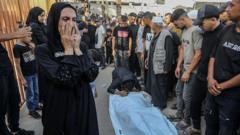In a tragic incident near an aid distribution center in Rafah, Gaza, the International Committee of the Red Cross (ICRC) reported that at least 21 individuals were "declared dead upon arrival" at a field hospital, amidst a "mass casualty influx" of 179 additional cases, including women and children suffering from gunshot or shrapnel wounds. This alarming report came as the Hamas-run civil defense agency claimed that 31 people had died due to what they termed "Israeli gunfire" targeting civilians.
In a stark counter, the Israel Defense Forces (IDF) have disputed the allegations, stating that their findings from an initial investigation indicated that IDF forces did not open fire on civilians near or within the humanitarian aid distribution site. The IDF released drone footage claiming to show armed individuals attacking civilians receiving aid in Khan Younis; however, verification of this footage by independent outlets, including the BBC, is hampered by restrictions on international media access to Gaza.
The Gaza Humanitarian Foundation (GHF), responsible for the aid distribution in question, denied any accusations of casualties at its site, labelling the reports as unfounded and promoted by Hamas. Yet, witnesses and medical personnel at the Nasser hospital, where many injured were treated, reported receiving around 200 patients with injuries from bullets or shrapnel.
The gravity of the situation has been underscored by Médecins Sans Frontières (MSF), who responded to the surge in injuries and noted the depletion of their blood supplies as they attempted to care for victims. The emergency coordinator for MSF criticized the prevailing aid delivery system as "dehumanizing, dangerous, and severely ineffective."
Local journalists reported an aerial assault occurring near the aid center, stating that Israeli tanks targeted the crowd while civilians were attempting to access crucial supplies. Inconsistent testimonies surrounding the events complicate the narrative, as some claim Israeli forces did fire into the crowd, while others suggest that they shot over their heads without causing harm.
With Gaza's health ministry reporting over 54,000 deaths since the escalation of conflict following Hamas's attacks on October 7, the situation continues to be characterized by desperation and volatility. As aid delivery processes falter and misinformation circulates, the international community must confront the ongoing humanitarian disaster while navigating the complexities of the narratives emerging from the region. The ramifications of such incidents highlight the urgent need for accountability and the restoration of trust in humanitarian efforts during this ongoing conflict.
In a stark counter, the Israel Defense Forces (IDF) have disputed the allegations, stating that their findings from an initial investigation indicated that IDF forces did not open fire on civilians near or within the humanitarian aid distribution site. The IDF released drone footage claiming to show armed individuals attacking civilians receiving aid in Khan Younis; however, verification of this footage by independent outlets, including the BBC, is hampered by restrictions on international media access to Gaza.
The Gaza Humanitarian Foundation (GHF), responsible for the aid distribution in question, denied any accusations of casualties at its site, labelling the reports as unfounded and promoted by Hamas. Yet, witnesses and medical personnel at the Nasser hospital, where many injured were treated, reported receiving around 200 patients with injuries from bullets or shrapnel.
The gravity of the situation has been underscored by Médecins Sans Frontières (MSF), who responded to the surge in injuries and noted the depletion of their blood supplies as they attempted to care for victims. The emergency coordinator for MSF criticized the prevailing aid delivery system as "dehumanizing, dangerous, and severely ineffective."
Local journalists reported an aerial assault occurring near the aid center, stating that Israeli tanks targeted the crowd while civilians were attempting to access crucial supplies. Inconsistent testimonies surrounding the events complicate the narrative, as some claim Israeli forces did fire into the crowd, while others suggest that they shot over their heads without causing harm.
With Gaza's health ministry reporting over 54,000 deaths since the escalation of conflict following Hamas's attacks on October 7, the situation continues to be characterized by desperation and volatility. As aid delivery processes falter and misinformation circulates, the international community must confront the ongoing humanitarian disaster while navigating the complexities of the narratives emerging from the region. The ramifications of such incidents highlight the urgent need for accountability and the restoration of trust in humanitarian efforts during this ongoing conflict.



















